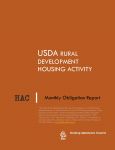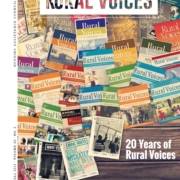HAC News: February 3, 2016
HAC News Formats. pdf
February 3, 2016
Vol. 45, No. 2
• February is National African American History Month • House approves bill with new fee for Section 502 guaranteed loans • Farmworker housing loans and grants available • Deadline extended for Section 533 HPG • HUD offers elderly supportive services demo • Capital Magnet Fund competition opens • FEMA considers disaster deductible from state and tribal governments • Community Facilities Technical Assistance and Training Grants program implemented • HUD requests input on over-income tenants • Nearly half of American households live paycheck to paycheck, report says • Investing in housing can save on health care • Save the date for the HAC’s third annual symposium on veterans • “Duty to Serve and What it Means for Rural America” HAC webinar planned
HAC News Formats. pdf
February 3, 2016
Vol. 45, No. 2
February is National African American History Month.
House approves bill with new fee for Section 502 guaranteed loans. On February 2 the House of Repre-sentatives unanimously passed H.R. 3700, the Housing Opportunity through Modernization Act of 2015 (see HAC News, 12/16/15). The bill as passed included an amendment, offered by Rep. Rubén Hinojosa (D-TX), that adds a fee of up to $50 to each Section 502 guarantee, to be used to enhance RD’s single-family IT and automated underwriting. The bill has not yet been considered in the Senate.
Farmworker housing loans and grants available. Preapplications are due April 12 for off-farm Section 514/ 516 funds for the construction of new off-farm FLH units and related facilities or the purchase and substantial rehabili-tation of existing non-FLH properties. Extra points will be given to projects based in or serving census tracts with poverty rates greater than or equal to 20% over the last 30 years. Request application packages from USDA RD state offices. Contact Mirna Reyes-Bible, RD, 202-720-1753.
Deadline extended for Section 533 HPG. Applications are now due March 15 rather than February 12 (see HAC News, 1/13/16). Contact a USDA RD State Office or Jeaneane Shelton, USDA, 202-720-5443.
HUD offers elderly supportive services demo. Owners of existing elderly-only HUD-assisted multifamily housing with at least 50 units, including Section 515 properties with Section 8, can apply for the Supportive Services Demonstration for Elderly Households by April 18. Contact HUD staff, mfsc@hud.gov.
Capital Magnet Fund competition opens. CDFIs and housing nonprofits are eligible for grants to provide loan loss reserves, capitalize loan funds, make risk-sharing loans, or provide loan guarantees for affordable housing or economic development. Deadline is March 30. Contact CDFI Fund staff, 202-653-0421.
FEMA considers disaster deductible from state and tribal governments. Comments are due March 21 on a proposal to require financial or other commitment from a state, tribal, or territorial government before FEMA will provide disaster assistance. For example, FEMA’s notice says recipients could potentially receive credit toward their deductible requirement through adopting enhanced building codes, or establishing and maintaining a disaster relief fund or self-insurance plan. Contact Jotham Allen, FEMA, 202-646-1957.
Community Facilities Technical Assistance and Training Grants program implemented. Send comments to USDA by March 14 on the final rule for a new program created by the 2014 Farm Bill. State and local governments, tribes, and nonprofits are eligible for grants to prepare reports and surveys necessary to request financial assistance to develop community facilities, or to provide an array of technical assistance services to others. Contact Nathan Chitwood, RD, 573-876-0965.
HUD requests input on over-income tenants. HUD is considering requiring PHAs to evict over-income public housing residents in some circumstances, following an inspector general’s report saying more than 25,000 families are over income (see HAC News, 8/5/15). Comments will be due 30 days after the request is published in the Federal Register on February 3. Contact Todd Thomas, HUD, 678-732-2056.
Nearly half of American households live paycheck to paycheck, report says. CFED’s annual Assets & Opportunity Scorecard also reports more than half of the nation’s credit users lack the credit scores needed (720+) to borrow money at prime rates. The 2016 Scorecard disaggregates the data for 18 of its 61 outcome measures by race, revealing that, for example, while unemployment rates have dropped nationally, workers of color are still nearly twice as likely to be unemployed as white workers. The report’s interactive website shows data for states and counties.
Investing in housing can save on health care. A research review by the National Housing Conference summarizes and evaluates recent research on the effectiveness of housing interventions to result in health care cost savings. A number of studies that have demonstrated that providing permanent supportive housing to homeless individuals can result in significant savings on public health care expenditures, usually more than enough to offset the cost of providing housing and services.
Save the date for the HAC’s third annual symposium on veterans. This year’s theme is the housing, health, services, and other needs faced by the rapidly expanding population of older veterans. To be held on May 18 in Washington DC, the symposium will showcase model programs that are providing vital assistance to these veterans. Contact Janice Clark, 202-842-8600, or Shonterria Charleston, HAC, 404-892-4824.
“Duty to Serve and What it Means for Rural America” HAC webinar planned. The session, to be held February 18 at 2:00 pm EST, will cover the proposed rule implementing Fannie Mae and Freddie Mac’s “Duty to Serve” (see HAC News, 12/16/15), focusing on the rural housing component of the rule, and is intended to help inform comments. To register click here or contact Lance George, HAC.


